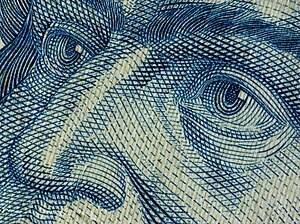

Intaglio (/ɪnˈtæli.oʊ, -ˈtɑːli-/ in-TAL-ee-oh, -TAH-lee-;[1] Italian: [inˈtaʎʎo]) is the family of printing and printmaking techniques in which the image is incised into a surface and the incised line or sunken area holds the ink.[2] It is the direct opposite of a relief print where the parts of the matrix that make the image stand above the main surface.
Normally, copper or in recent times zinc sheets, called plates, are used as a surface or matrix, and the incisions are created by etching, engraving, drypoint, aquatint or mezzotint, often in combination.[3] Collagraphs may also be printed as intaglio plates.[4]
After the decline of the main relief technique of woodcut around 1550, the intaglio techniques dominated both artistic printmaking as well as most types of illustration and popular prints until the mid 19th century.
[5] The word "intaglio" describes prints created from plates where the ink-bearing regions are recessed beneath the plate's surface. Though brass, zinc, and other materials are occasionally utilized, copper is the most common material for the plates.
- ^ "intaglio". Lexico UK English Dictionary. Oxford University Press. Archived from the original on November 23, 2021.
- ^ Strauss, Victor (1967). The printing industry: an introduction to its many branches, processes, and products. Washington: Printing Industries of America. ISBN 0835202720.
- ^ Mustalish, Rachel (2003). "Printmaking Techniques of the WPA Printmakers". In Lisa Mintz Messinger (ed.). African American Artists, 1929–1945: Prints, Drawings and Paintings in the Metropolitan of Museum of Art (Metropolitan Museum of Art). Yale University Press. pp. 86–88. ISBN 0300098774.
- ^ Mueller White, Lucy (2002). "Intaglio Processes". Printmaking as Therapy: Frameworks for Freedom. Jessica Kingsley. pp. 108–109. ISBN 1843107082.
- ^ Network, Artists (2017-09-29). "Intaglio Printmaking Made Simple | Here Are The 5 Key Processes". Artists Network. Retrieved 2024-03-01.




